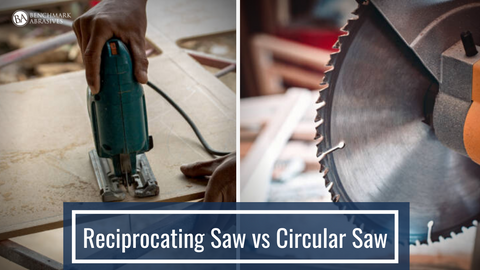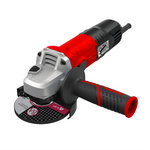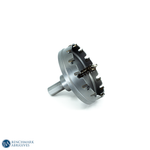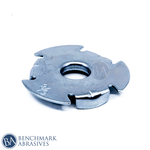
Reciprocating Saw vs. Circular Saw

Power saws come in wide different varieties. The reciprocating saw and circular saw are two of the most popular. Despite having wildly varying sizes, shapes, and aesthetics from one another, all saws perform specific similar tasks. The following sections compare circular and reciprocating saws to decide which is more practical for you.
Before discussing the distinctions between these two power tools, let's briefly review what each cutting tool is. This will enable you to comprehend each tool at its most fundamental level.
Reciprocating Saw
A reciprocating saw, commonly referred to as a "recipe saw," is a powerful tool to quickly move back and forth and "reciprocate" through materials. The narrow, knife-shaped blade of a reciprocating saw is used to achieve this; it is often serrated on one side. These saw blades are available in various designs that are very effective for slicing through masonry, metal, and other materials.
Similar to a tiny gun, a reciprocating saw has an extended shape. A trigger and grip in the form of a pistol are located at the butt end. The blade that faces outward is situated at the other end. A user can support and steady their reciprocating saw in the interim by placing a hand slightly behind the chuck.
Pros:
- Versatile: Reciprocating saws are flexible. Hence, it can be used in a wide range of applications and even for different types of materials like masonry, wood, drywall, and even plastic.
- Power tool: it can easily cut through thick materials due to its power.
- Ideal for compact areas: reciprocating saws are ideal for compact areas and curves due to their straight blades and compact size.
- Ideal for demolition: this saw is an expert in cutting old pipes, removing nails, and other demolition tasks.
Cons:
- Create noise and vibrations: reciprocating saws generate a significant amount of noise and vibrations, which is disturbing to work.
- Less precise: compared to a circular saw, a reciprocating saw provides rough cuts and is less precise for straight and accurate cuts.
Circular Saw
As its name suggests, a circular saw typically has a round form. For that purpose, a circular saw is a powerful tool that effectively cuts through various materials using a blade shaped like a disc. A circular saw can easily make plunges, crosscuts, and rip cuts because of how quickly the edge turns when in motion. Usually, these cuts turn out moderately smooth. (Read More: Types of Circular Saw Blades)
A circular saw can be operated with two hands and is a two-handed power tool. Typically, a user will rest one hand on the guidepost that serves as support, which is situated close to the top or front of the device. After that, they put their second hand on a parallel support point in the back, where the ignition switch is. These saws also include a hood over the top of the blade housing to stop debris from being thrown at the user.
Pros:
- Accuracy: A circular saw makes straight and precise cuts in wood. It also gives a smooth finish.
- Versatility: A Circular saw is widely utilized for bevel cuts, ripping, and crosscutting.
- Efficiency: circular saws are great at producing quick and effective cuts compared to reciprocating saws.
Cons:
- Not suitable for compact areas: circular saws are not ideal for cutting in tight and compact spaces and curves.
- Safety: to avoid kickbacks and other accidents, be careful in handling circular saws.
- Limited material use: it can be used for different applications but is not suitable for different materials like plastic and other metals. It is mainly used for wood.
Difference Between Reciprocating Saw and Circular Saw
Now that you are familiar with the fundamentals let's examine their differences in more detail.
1. Type Of Blade
One of their most noticeable differences is the type of cutting blade used by a reciprocating saw and a circular saw. As a result, each edge has a strikingly diverse shape, which influences its level of performance.
For instance, a circular saw employs a disc-like blade with several tooth types, but a reciprocating saw utilizes a knife with a knife-like serration. Even when the saws are not in use, these variations are visible from a distance
2. Ability To Cut
Reciprocating and circular saw blades have distinctly different cutting capacities due to their varied blade designs and sawing processes.
A reciprocating saw, for instance, can often cut through a wood plank more quickly while still leaving a rough cut edge. A circular saw, in contrast, may take a little longer to complete a cut, but the cut edge of the same wood is left much cleaner.
Similarly, the functional flexibility of these two saws varies. For example, the smooth dimension cuts required for a successful carpentry project can be made more effectively using a circular saw. In contrast, a reciprocating saw can only handle simple, rough dimensioning tasks.
3. Shape Factor
Both saws have very different form factors when holding them in hand. A circular saw is focused around the unit's main disc blade and, as its name implies, is circular. On the other hand, a reciprocating saw is typically carried like a rifle and is long.
Even though these tools typically require two hands to operate, the user's hand placement varies greatly depending on the balancing requirements of each unit.
4. Price
Based on their typical retail pricing, reciprocating and circular saws can also be distinguished. For instance, the cost of a reciprocating saw typically ranges from $50 to $150. On the other hand, although a circular saw typically costs more (between $100 and $250 on average), its increased cost generally is justified by its better degree of usefulness and precision.
5. Uses
Although there are significant variations between the reciprocating and circular saw in terms of blade type, form factor, and appearance, it is possible to argue that the uses of each saw differ most.
To put it simply, the circular saw is used for building or construction operations. The reciprocating saw, however, is used to demolish or destroy objects or materials. This should make deciding which option is appropriate for your needs easier.
Reciprocating Saw vs. Circular Saw: What to Choose?
These two saw types are best suited to various jobs, as one might anticipate. For instance, the reciprocating saw is an expert in deconstruction and destruction. This is because it can rapidly and effectively cut through metal and wood (including nails). Even better, the saw's unique shape makes it easy for users to maneuver it into tight locations where other power saws cannot.
In contrast, a circular saw is a far more versatile piece of equipment when cutting in the carpentry style. To achieve this, circular saws are often more powerful and can cut through highly resistant materials when equipped with the right blade. Additionally, circular saws "kick" much less than reciprocating saws, making them easier for beginners.
Conclusion
The reciprocating and circular saw are two different types of power tools, as should be abundantly evident by this point. They are better suited for various construction and demolition operations and are not intended to be used interchangeably. Please keep all these differences in mind to ensure that your team always has the resources it needs to succeed.



































































